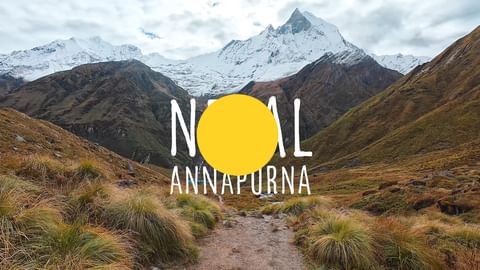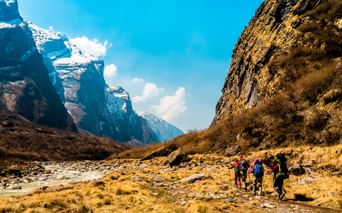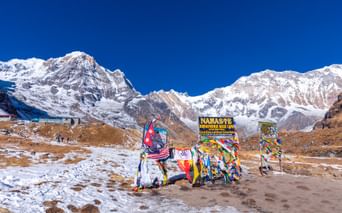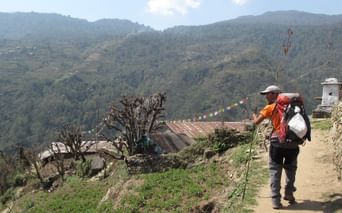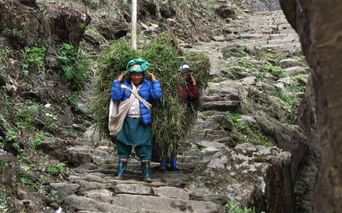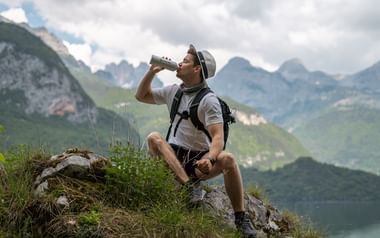Free cancellation up to 35 days before departure
This tour is covered by our special free cancellation policy up to 35 days before departure.
Itinerary
Upon arrival in Kathmandu, you'll be met at the airport by your guide and driven through the vibrant city to your hotel, centrally located in the charming neighbourhood of Thamel. Enjoy the rest of the day at leisure to stroll through the narrow streets of Thamel and browse the shopping opportunities and equipment shops, or perhaps grab a coffee at one of the many cosy cafés.
Accommodation: 3 star hotel***
Hotel (example): Kathmandu Garden Home
oday there is a guided tour to two famous temples. The Hindu Pasupatinath and the Buddhist Buddhnanath. You'll be met in the morning by a local guide and after a delicious breakfast you'll be shown around the city. The Hindu temple of Pasupatinath, dedicated to the god Shiva, is located on the banks of the sacred Bagmati River. Built in pagoda style with beautifully carved silver doors, it is one of the holiest temples in Hindu culture. Pasupatinath Temple is the destination for Hindu pilgrims from all over the world during Shivartri. Only Hindus are allowed to enter the central courtyard of the temple. Tourists are ‘content’ to view the temple from the opposite bank of the Bagmati River.
Next is the Buddhist temple of Bouddhanth, which is the largest Stupa (Buddhist earthen mound) in South Asia and the centre of Buddhism in Nepal. The ancient and colossal Stupa was built in the 6th century by King Man Dab of the Lichhabi dynasty. The stupa rests on three large terraces and from above it takes the shape of a lotus flower, which is a very sacred flower for Buddhists around the world.
Accommodation: 3-star hotel
Guided tour: approx. 4-5 hours
Hotel (example): Kathmandu Garden Home
You will be picked up at the hotel and driven to the airport for your flight to Pokhara. The city is located at an altitude of 915 metres at the foot of the Annapurna massif and Machhapuchare (Fishtail Mountain). Upon arrival in Pokhara, you'll immediately drive to the village of Tikhedhunga, where you'll have lunch before starting the trek. The trek is only 1.5 hours, but it climbs steeply to Ulleri, a cosy village with views of Annapurna South and the peak of Fishtail Mountain.
Flight: approx. 25 min
Drive approx. 2.5 hours
Today's trek: approx. 1.5 hours
Hotel (example): Teahouse
You'll start your trek gently uphill from Ulleri to Banthanti and then walk through the forest to Nagethanthi for lunch. From here, follow the trail to Ghorepani. The village lies just below Poonhill and is surrounded by rhododendron forest. From this beautiful village you'll have views of the Annapurna and Dhaulagiri Mountains.
Hotel (example): Tea House
This morning you'll start your hike before dawn and head to the top of Poonhill to see the sunrise - a wonderful experience. The hike takes about an hour. The panoramic views cover more than 10 mountains, including the Annapurna range and Dhaulagiri. Enjoy a hot cup of coffee/tea at the summit before returning to your teahouse for breakfast. After breakfast, embark on today's trek through the beautiful forest to Tadapani. It's a long stage today, but it's full of beautiful views. You'll spend the night in Tadapani.
Hotel (example): Teahouse
After breakfast with views of the mighty Himalayan peaks: Annapurna South, Fishtail and Hiunchuli, you begin your trek. The day starts with a descent to a river, after which you cross the suspension bridge and walk uphill to Chhomrong. You'll pass beautiful forests and small settlements of the Gurung people on your way, giving you a new perspective on the Himalayan lifestyle. You'll spend the night in Chhomrong.
Hotel (example): Tea House
After breakfast, follow the path down to a river that leads you back up after crossing the bridge over the Chhomrong Khola. You'll pass the small villages of Sinuwa and Bhanuwa on the way up to Sinuwa. After walking in the beautiful stretch of forest and passing Khuldighar, you'll make a short descent to reach Bamboo for lunch. After lunch, you'll walk for about an hour and a half to reach Dovan - a small place nestled in a deep gorge with only a few teahouses for accommodation.
Hotel (example): Tea house
You'll start your day in the morning with a trek up from Dovan towards Deurali. You'll walk at a leisurely pace throughout the day as you're now at an altitude that can be felt on your body. The trail to Deurali passes through a beautiful forest of rhododendron and bamboo with views of enchanting waterfalls on both sides of the river. Overnight accommodation in Deurali
Hotel (example): Teahouse
You'll start early in the morning to get on the good side of the weather, but also to have time for a leisurely hike to Annapurna Base Camp (ABC), In the spring months there may be a risk of snow in this area and therefore the guide's judgement will determine where and when you hike. You hike along the river and reach Machapuchare Base Camp (3,700 metres). Here you can take a break and have a cup of hot tea. You then continue at a leisurely pace to accommodate the altitude - you're in a zone where altitude sickness is also a factor. The slow climb helps to acclimatise your body. You'll reach Annapurna Base Camp where you'll spend the night, enjoy lunch and explore the area.
At ABC there are (cloud permitting) unobstructed views of Annapurna 1 (as well as other peaks). What's particularly impressive here is that you're standing at just under 4200m looking up at a peak that's over 8,000m - that is, there's a view of an ice wall towering almost 4km above you. It cannot be described, it must be experienced.
Hotel (example): Tea house in ABC
Wake up early and take your morning coffee outside in the cold fresh mountain air and enjoy the magical atmosphere as the sun's first rays hit the Annapurna massif. Once you've digested breakfast and the impressive view, it's time to begin the descent. It's a merry descent and within an hour you'll be back at Macchapuchare Base Camp. You'll follow the same route down across the col, but looking south down the valley is a completely different experience. The hike is marvellously easy and the air becomes noticeably thicker. Before you know it, you'll be down in the forest and by mid-afternoon you'll be checking in at the tea house in Bamboo (2,300 metres).
Hotel (example): Teahouse
After breakfast, you'll begin today's trek down the trail. Even though you're descending, there's still a steep ascent to Chhomrong. You'll pass the villages of Sinuwa and Chhomrong and then descend steeply to Jhinu Danda. Depending on the time available, you can enjoy a visit to the natural hot spring, located about 25 minutes down a side path by the river. It's small and cosy, with pools built into the rock wall to retain the water. It's definitely worth the effort. You'll spend the night in Jhinnu Danda.
Hotel (example): Teahouse
After breakfast, descend along the river through beautiful forests and waterfalls until you reach New Bridge. From there you'll ascend to Landruk, a picturesque village inhabited mainly by Gurung ethnic groups and a few Brahmins. You'll have lunch here before travelling via Lumle to Pokhara.
After some rest, you can explore the area around the lake. Overnight at a hotel in Pokhara.
Hiking: approx. 3 hours
Driving: approx. 2 hours and 15 minutes
Hotel (example): 3-star hotel in Pokhara
Today you'll visit the main sights around Pokhara. After breakfast, drive to Pumdikot where the newly built Shiva statue is waiting to give you its blessing. From here you'll have a great view of Lake Phewa, Pokhara city and the mountains. Next, you'll visit the World Peace Stupa, a peaceful monument that stands as a symbol of hope and harmony for the world of peace and unity. Perched on top of a hill overlooking the beautiful Phewa Lake, the stupa offers breathtaking panoramic views of the Annapurna mountain range.
Next, descend to Devi's Fall, a waterfall of approximately 150 metres that drops 30 metres below ground level. In Nepali it is called Patale Chango, derived from the literal translation of Paatal Ko Chango, which means ‘Waterfall of the Underworld’. Just opposite Devi's Fall, you'll visit Gupteshwor Mahadev Cave, considered the most famous and longest cave in Nepal (2950m), it was discovered in the 16th century. You will then return to the lakeshore for lunch.
In the afternoon, visit the International Mountain Museum where you can learn about the extensive mountain ranges of Nepal, their ethnic groups and their lifestyle. You can also learn about international mountains and the lifestyle of famous mountaineers. The museum has an impressive collection of artefacts, original mountain equipment, stories and photographs of the mountains, their inhabitants and some of the first adventurers to climb the world's highest peaks.
In the early evening it is possible to take a boat trip on Lake Phewa, the beautiful 5 square kilometre lake with magnificent mountain views.
Guided tour: approximately 5-6 hours
Hotel (example): 3-star hotel in Pokhara
Today you'll have a relaxing morning. After a late breakfast, you'll fly to Kathmandu and stay overnight at a hotel. The rest of the day is at leisure. Sightseeing on your own, shopping, or pure relaxation.
Hotel (example): Kathmandu Garden Home
Today is a guided tour of Kathmandu.
During this walking tour, you'll explore the local market Ason, the pearl market Indrachowk, the oldest supermarket - New Road and the Hidden Stupa. After discovering these little gems of Kathmandu, head to Kathmandu Durbar Square, known for its unique historical, cultural and religious traditions. There's also a special experience in store with a visit to the temple of the living goddess ‘Kumari.’
The Durbar Square walking tour will be a perfect blend of culture, history, art, architecture and traditional values prevalent in the Kathmandu Valley. After the tour, you'll have time on your own to shop for the last few souvenirs or simply soak up the atmosphere of the city.
Duration of the guided tour: 4-5 hours
Hotel (example): Kathmandu Garden Home
You will be picked up at the hotel and driven to the airport for your return journey. Breakfast included.
Pictures from the trip














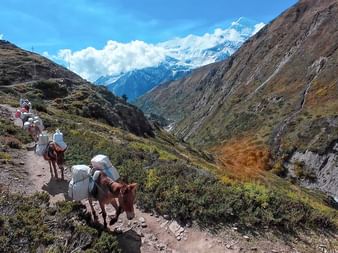



Prices and dates
Price includes
- A highly experienced local alpine mountain guide and porters to transport your luggage on the trek
- 4 nights in Kathmandu at Kathmandu Garden Home*** hotel
- 2 nights in Pokhara at a 3-star hotel
- 10 days trekking in the Himalayas with accommodation in tea houses
- Breakfast every day in Kathmandu and Pokhara
- All meals on the trek ( including hot drinks 3 times daily)
- Briefing with our staff on arrival in Kathmandu
- Transport from/to the airport (always private transport)
- Land transport (always private transport)
- Local flight tickets (Pokhara - Kathmandu)
- Guided sightseeing in Kathmandu
- Guided sightseeing in Pokhara
- All temple tickets on sightseeing tour in Kathmandu
- All trekking permits (remember to bring your passport photo)
- Food and drinks, cabins, above average salary, insurance, medical equipment, flight tickets, ground transport for trekking staff
- TIMS (Trekker's Information Management System)
- Free loan of a backpack (approx. 75 litre backpack in which you can pack your belongings for the trip. Handed out in Kathmandu)
- Free loan of sleeping bag (available in Kathmandu)
- Free loan of down jacket (provided in Kathmandu)
- All taxes and fees
- 24-hour local and international service hotline for the duration of the tour
- This is a package holiday and is covered by the Travel Guarantee Fund and the Package Travel Act - see what benefits this brings you - click here
- Flight to Kathmandu
- Lunch and evening meals in Kathmandu and Pokhara
- Travel insurance and cancellation insurance
- Tips (expect approx. 100-120 USD per person)
- Handling fee (€20)
- Visa to Nepal (we recommend applying from home, but this can also be done at the airport on arrival)
Practical information
This is an individual trip, which means you are alone on the tour (with a guide and porter) and that you will not be grouped with other travelers unless you specifically request this.
If you are an odd number of travelers, it will be necessary to select a single room for one person.
Check the price quickly You can quickly check the price of your desired trip without having to fill out anything. Here’s how:
- Choose your desired start date
- Click the green button "See price and reserve your vacation" and go to the booking form
- Select the number of people and any additional options and see the price at the bottom of the page (you do not need to fill out anything on the form).
Request a quote If you want, for example, airfare included or changes to the trip, you can request a quote for this by using the "Receive offer" button. Remember to describe thoroughly what changes you would like.
The booking process When you book the trip, we start booking hotels and arranging all the practical aspects of the tour. This process typically takes 2 working days, but it may take longer for some bookings. If you are arranging your own transport, we recommend waiting to do so until we have confirmed your booking.
Dates If you can select the date in the trip's calendar at the top of this page, this is a possible start date. We continually update trips with sold-out dates, after which those dates turn red and cannot be selected.
The flights to/from Kathmandu are not included in the price. You can easily find a suitable flight via a flight booking engine such as Momondo or Skyscanner.
Notice: we recommend that you book with us and wait for the confirmation before you book your flights.
Airport transfers
When you arrive at the airport in Kathmandu, you will be picked up regardless of when you arrive. It doesn't matter if your flight arrive at night.
Get a quote
If you prefer that we handle your flight, then we would be happy to arrange this for you. You simply book a quote below the map on this page and we will return with a quote as soon as possible (usually within 48 working hours). Please note that we add a handling fee of 45 euro to each flight and this means that the flight will be cheaper if you book it yourself.
The trekking tour is led by a local English-speaking Sherpa guide who has extensive trekking experience in Nepal. To best assist the participants of the trip, there will be an assistant guide or more from groups over 5 participants. You will have porters or yaks to carry your luggage. One porter usually carries the luggage for two participants and once you have dropped off your equipment bag in the morning, there is no way to get to it until you arrive at your accommodation. The porters and yaks are hired locally in the area by our local partner who we have worked with for many years. Our partner also ensures that porters are properly insured, paid above average wages and generally have fair working conditions.
In Kathmandu you will stay in a centrally located tourist class hotel. Breakfast is included at the hotel. On the trek you will sleep in small local teahouses, or lodges, as they are called in Nepal. The lodges are small guesthouses run by local families. The quality varies, but our guides strive to be book the best lodges for you, but you must be prepared, that the lodges are in relatively primitive conditions.
You will usually find blankets on the beds, but they are not warm enough at high altitude and you must bring your own sleeping bags on the trek. Some places it is possible to get a hot shower, which typically consists of a bucket of hot water. Please make sure whether the water is heated by solar energy in order to protect the vulnerable forest growth.
In Kathmandu and Pokhara, breakfast is included in the price. Lunch and dinner is not included. There are plenty of nice restaurants located near the hotel and you can also eat at the hotel. It is usually cheap to eat at restaurants in Kathmandu. On the trek you will have to buy all the meals at the lodges. You will eat your breakfast and dinner at the lodge where you spend the night and you can buy lunch on the lodges you pass by during the day. The menus are basically the same in all lodges, but it is good solid food with lot of meat, rice, potatoes and vegetables.
You can buy clean bottled water as well as soft drinks. hot tea, coffee and beer in most lodges. There is a farewell dinner with the guide included on the last evening in Kathmandu.
A typical trekking day in Nepal may look like this:
06:30-07:00: Morning wake-up at the teahouse
Get dressed and ready. Your luggage is given to the porters and pack animals.
08:00: Breakfast at the teahouse
08:30: The day's trekking begins
It's important to walk at your own pace and take the breaks you need.
11:30: A good long lunch break for about 1-2 hours
13:00-13:30: The afternoon trek begins
15:00-16:00: Arrival at the next teahouse, where you have time to relax, explore the village, or read a good book
18:00-19:00: Dinner is served, and you choose from the menu
This trip has a difficulty level of 4.
Grade 4
Demanding hiking with daily marches of 6-8 hours, often in difficult terrain at higher altitudes. There can be longer ascents of up to 1,000 meters. Requires good physical condition, endurance, and knees and ankles capable of enduring prolonged descents. You need to be in good health and preferably have hiking experience. Requires good hiking boots and regular outdoor clothing. There can be significant temperature differences.
Read more about our grading system here.
Area: 147,181 km²
Population: Approximately 26 million
Religious Holidays/Festivals
Nepal is primarily a Hindu country, heavily influenced by Buddhism. Therefore, there are many religious holidays. Several of the major holidays fall during trekking seasons and can affect activity levels. Take it easy if things don't go according to plan; everything always works out. Diwali is a major Hindu festival of lights also celebrated by Buddhists, among others. The celebration symbolizes the victory over evil. Diwali also honors the Hindu goddess Lakshmi, who represents prosperity, wealth, and beauty. The festival days vary with the lunar calendar each year. In 2016, Diwali is celebrated in the last week of October.
Electricity
You can charge batteries at lodges and hotels. The power voltage is 240 volts, but it can vary greatly in the mountain areas. It is recommended to bring a multi-plug adapter with several options.
Phone and Internet
Country code: +977
Remember to disable automatic updates, data roaming, etc., on your phone/tablet to avoid a surprisingly large bill when you return home. There is increasingly Wi-Fi in many teahouses in the Annapurna area. There is network coverage in many places during the trekking tour, but it is expensive to call home, so many choose to stay in touch with family via SMS. However, there will be areas where it is not possible to get a connection.
Language
Nepal's official language is Nepali, but many dialects are also spoken. Our local guides speak English well, though usually with an accent. In hotels, teahouses, and shops, English is also spoken well. The porters on the trekking tour do not always speak English very well (and yaks not at all!).
Dress Code
In general, the dress code in Nepal is very relaxed, even at the better hotels. It is important to dress with respect for religion and local customs. Therefore, dress modestly and consider when it is appropriate to wear shorts, especially if you are visiting temples and monasteries. It is good etiquette to have your shoulders and knees covered.
Time Difference
Nepal is 4 hours and 45 minutes ahead of Denmark and 3 hours and 45 minutes ahead of Denmark when we have daylight saving time.
Photography
There are countless photo opportunities in Nepal, so make sure you have enough space on your memory card. Show respect for people and ask for permission before taking pictures of them.
Currency and Price Level
The local currency is the rupee (NPR). In Kathmandu, there are many ATMs where you can withdraw money, as well as exchange offices where you can exchange cash in dollars and euros. We recommend that you withdraw/exchange an appropriate amount for the trekking tour before leaving Kathmandu. Most teahouses only accept rupees as a means of payment. Check www.valutakurser.dk for current exchange rates.
Tips
It is customary to give tips in Nepal. In restaurants, the amount is rounded up to about 10% of the bill. It is also common to tip guides and porters, and you should expect to give approximately 80-120 US dollars in tips per person. A good rule of thumb is that for every 10 USD the guide gets, the porters get 6 USD.
It is the customer’s responsibility to have a valid passport. It is also the customer’s responsibility to seek and obtain any necessary visa for travelling to the booked destination. Your passport must be valid for at least 6 months after the expected return. Note that there may be special visa requirements for different foreign nationalities. Please note that processing time for visas to some countries may be several weeks. Mountain Adventures have no responsibility for any lack of travel documents. Be aware of any transit visa requirements.
We advise you to contact a medical specialist or you personal doctor or a licensed vaccination clinic. Please note that you should bring your vaccination certificate when you travel to Nepal.
We recommend taking out travel insurance that covers at least illness, accident, repatriation, lost holiday, luggage and liability. As a customer, you are responsible for taking out the necessary travel insurance to cover these costs.
Before taking out insurance, you should check whether you are already covered by travel or cancellation insurance through your home insurance company, credit card or similar - please note that there may be differences in insurance coverage.
After booking this trip, you get access to various discount schemes.
The best seasons for trekking in the Annapurna area are spring and autumn. March, April, May and October, November are great times to go trekking. The weather is usually clear and sunny in the morning and early afternoon. During the afternoon, clouds often form from the evaporation of snow in the mountains and then it often clears up again in the evening. January and February are very cold at high altitudes. Summer from June - September is characterised by monsoon rains. In Kathmandu the temperature is approximately 25 - 30 degrees. In the mountains, the temperature varies depending on the altitude. In the lowlands it can be up to 30 degrees during the day. At Annapurna Base Camp it can easily be 15-20 degrees in the middle of the day, but when the sun goes down, the temperature drops drastically to minus 5-8 degrees below zero.
Here is no text
Travelling to Nepal is always an adventure and you should be prepared for changes along the way. Bering Travel and our good partners always strive to carry out the trips according to the programme, but there may be local conditions and situations where it may be appropriate to adjust the programme along the way. For example, political or natural conditions may cause the guide to change the programme. It may also be the physical ability of the participants, unsuitable climbing weather or delayed flights that require changes to the programme. An extra day is included for summit attempts to maximise the chances of success. It will always be the main guide's decision whether it is safe to attempt the summit. We and our partners always do our best to execute the promised programme, but we are not master of the weather and wind, so if there are changes along the way, take it as an experience.
